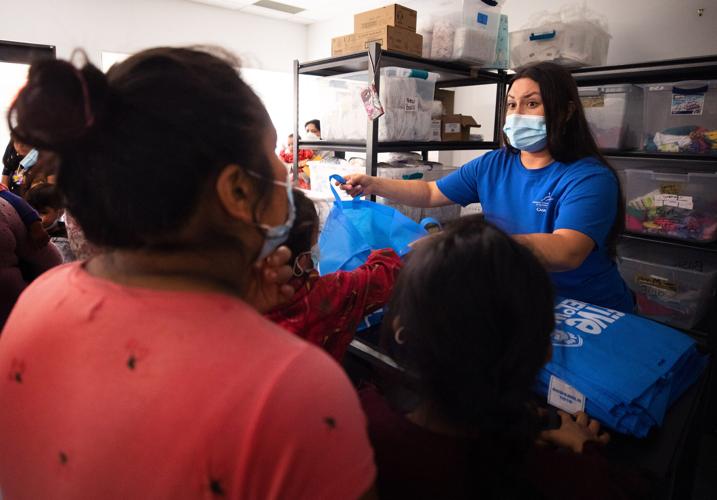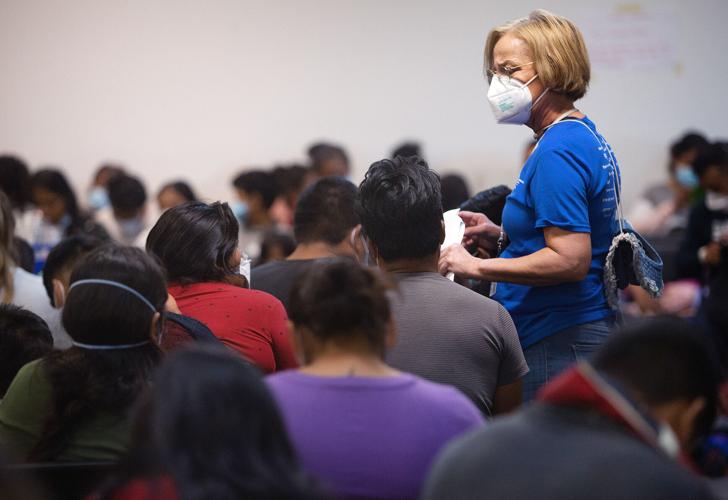Emergency managers in Pima, Santa Cruz and Cochise counties are still straining to manage the arrival of legal asylum seekers released by U.S. border agents, who are facing record numbers of migrant families crossing the southern border.
The number of arrivals in Pima County eased slightly over the weekend, said Shane Clark, director of Pima County’s Office of Emergency Management. But county officials and partner humanitarian organizations, like Casa Alitas in Tucson, are still walking a tightrope, he said.
“It’s kind of a daily chess game,” Clark said. “We are always reactive to how many (people) Border Patrol releases. We are appreciative of the partnership we have with Border Patrol. … But really, we’re at their mercy.”
Typically, Border Patrol agents are able to give advance notice before releasing asylum seekers directly to county- or state-funded buses for transport to shelters in Tucson or Phoenix. After these “coordinated” releases, migrants usually stay in Arizona shelters for less than 48 hours before traveling to family or sponsors in the interior of the U.S.
But since mid-September, a surge in encounters at the border with Mexico has compelled Tucson Sector border officials to process migrants as quickly as possible to maintain safe conditions in their detention facilities.
That’s meant small border towns like Bisbee, Naco, Douglas and Nogales, Ariz. have had to cope with unannounced, and usually hourly, releases of asylum seekers in communities that don’t have the infrastructure to care for them.
The migrants released into border communities have been legally cleared to await their asylum hearings in the United States. Most only stay in those small towns for a few hours until buses arrive to transport them to shelters in Tucson or Phoenix.
Pima County and the Arizona Department of Emergency and Military Affairs, or DEMA, have been sending dozens of buses across the state each day to transport asylum seekers to aid groups like Casa Alitas.
But local emergency managers have had to scramble to connect those travelers with transportation, plus food and water, to ensure they won’t remain unsheltered overnight.
Casa Alitas in Tucson is still receiving upwards of 1,000 migrants a day, Clark said.
Casa Alitas has come close to exceeding capacity, but so far that hasn’t happened, said Diego Piña Lopez, agency director for Casa Alitas. The lack of predictability remains a challenge, he said.
“Because we’re not getting clear insight into the numbers being dropped off at any given time, it’s still challenging to know what we’re working with for the day or the next day,” he said. “We need more clear information on what’s coming down the pipeline to us, as best as DHS (the Department of Homeland Security) is able to provide.”
August statistics
The latest statistics from U.S. Customs and Border Protection show that in August, Tucson was once again the busiest of the nine southern-border sectors, with border agents encountering nearly 49,000 people between ports of entry. An additional 4,115 people presented themselves at ports of entry to request asylum.
For the first time since President Biden took office, more people crossing the southern border were part of a family unit, rather than single adults, said Ariel Ruiz Soto, senior policy analyst for the Migration Policy Institute. The increase in Tucson was largely driven by families coming from Mexico and Central America, he said.
Border-wide, apprehensions were up significantly in July and August, after dropping in May and June, when Biden’s new border policies and restrictions were implemented.
The volume of arrivals has rivaled the crisis situation in May, when Pima County nearly experienced the street release of migrants due to lack of shelter capacity. That came on the eve of the expiration of Title 42, the pandemic-era measure that allowed the federal government to expel some migrants from the country immediately, before giving them the opportunity to request asylum.
After days of receiving dozens of daily street releases in Cochise County — including many dropped off at a Safeway parking lot in Bisbee, before the town established a respite-shelter location — the volume of arrivals has slowed this week, giving officials more time to gather supplies and engage volunteers.
This week, “our shelter and respite operations are in a much more prepared stance,” Daniel Duchon, director of Cochise County Emergency Management, said Tuesday.
On Sept. 15, Cochise County received 132 asylum seekers in one day, compared to 36 on Monday, Duchon said. Since August, the community has received more than 680 asylum seekers released from Border Patrol custody.
Santa Cruz County has been receiving between 200 and 300 asylum seekers released by border agents each day since mid-September, said Sobeira Castro, director of emergency management for Santa Cruz County.
Nogales has a small homeless shelter, but its capacity of 10 wouldn’t help much if Tucson and Phoenix’s shelters end up reaching their capacity, Castro said. That could force asylum seekers to stay in border communities overnight, which could become a humanitarian and safety issue if they are unsheltered, she said.
Earlier this month the Pima County Board of Supervisors unanimously approved devoting up to $4.1 million of the county’s federal American Rescue Plan Act funding to go toward the purchase of Casa Alitas’ Drexel Road congregate shelter, which the county has been leasing. The shelter provides 350 beds for the region’s migrant-aid effort.
The state, through its ARPA allocation, will pay the remaining half of the building’s purchase price, said Supervisor Adelita Grijalva, who sponsored the motion.
The purchase will ensure continuity for shelter managers and will allow for needed renovations. If the number of asylum seekers relents in the future, all or part of the shelter can easily be modified for other uses, such as general emergency housing, she said on Tuesday.
Back in late 2022, “it took months to find this Drexel facility, and we wouldn’t want to have to uproot all of those services” if the property owner decided to stop leasing it, she said. The purchase is crucial for the county’s continued ability to house large numbers of migrants from throughout the region, Grijalva said.
“Pima County has been doing a lot of heavy lifting, for not just the state of Arizona, but for the country, when it comes to asylum seekers coming across our border,” she said.
Officers reassigned
This month U.S. Customs and Border Protection reassigned 50 officers from Arizona’s ports of entry to instead focus on processing migrants, in order to “decompress” the region’s busy detention facilities and “to ensure the safety and well-being of those in the agency’s custody,” a CBP statement said. The reassigned officers have been supporting the Tucson and Yuma border sectors with processing migrants since Sept. 16.
“That support will continue on an as-needed basis,” the statement said. “CBP will work to return to normal operations as quickly as feasible.”
Travelers and the cross-border trade community may face longer than normal crossing times at Arizona ports of entry, CBP acknowledged. The public can view current wait times at the CBP website.
In a Sept. 21 news release, Arizona Gov. Katie Hobbs said the decision has resulted in extended wait times at the ports, and quicker migrant processing has resulted in the accelerated release of asylum seekers into border communities. That is “shifting pressure from federal facilities to local communities,” the release said.
“Time and again I’ve asked the Biden administration for assistance at the border, but instead they have chosen to redirect resources to speed the release of migrants, without the support and coordination our local communities deserve,” Hobbs, a Democrat, said in a statement. “Arizona is being overwhelmed, and we can’t afford to lose manpower at our ports of entry. ... The federal government needs to do its job and take action to ensure our border is secure and the migration process is orderly and humane.”
Driven by misinformation
The Biden administration’s border policies that replaced Title 42 are focused on expanding legal avenues to enter the U.S., while increasing penalties for those who enter without authorization. Penalties include a five-year bar on re-entry and loss of eligibility to access lawful pathways to enter the country. The primary lawful pathway to enter the U.S. is by making an appointment through the CBP One mobile app.
In August, more than 45,400 people used the app to make an asylum appointment, CBP data show. Advocates have criticized the app for being insufficient for the large number of migrants waiting for appointments in Mexican border towns, where they’re vulnerable to exploitation or kidnapping.
U.S. Customs and Border Protection officials say migrants are being fed misinformation about how easy it is to cross the border by human smugglers, who seek “to prey on vulnerable individuals.”
A new poll, first reported on Tuesday by the Dallas Morning News, suggests “disinformation” is encouraging migrants to make the trip.
The poll, funded by America’s Voice, a national advocacy group that supports immigration reform, interviewed 600 randomly selected Central Americans between the ages of 16 and 39 who were living in El Salvador, Guatemala, Honduras and Nicaragua.
Nearly one in five people surveyed said they believed the U.S. had open borders and that most migrants can apply for asylum if they make it to the border. Among the youngest cohort surveyed, ages 16 to 24, more than one-third reported hearing U.S. officials or politicians claim the border is open, and most of them reported hearing it on social media.
Human smugglers are echoing pundits’ rhetoric on “open borders” in order to profit off migrants who decide to make the journey north, Vanessa Cárdenas, executive director of America’s Voice, said in a Tuesday statement.
Right-wing politicians and media outlets are some of the “leading drivers of ‘open borders’ disinformation,” Cárdenas said in the statement.
Politicians are “likely spreading this fabrication for political purposes,” she said. “Yet this relentless political disinformation about the state of the U.S. border filters into Central America, falls on the ears of desperate people looking for a way out and empowers smugglers and other bad actors.”
Get your morning recap of today's local news and read the full stories here: tucne.ws/morning.





